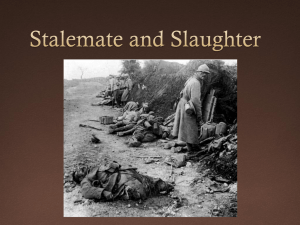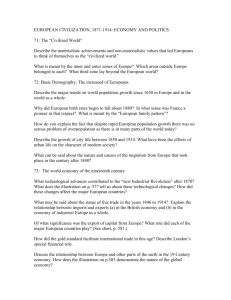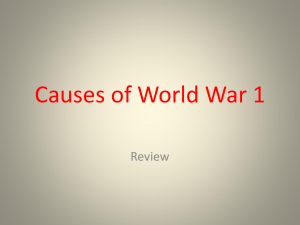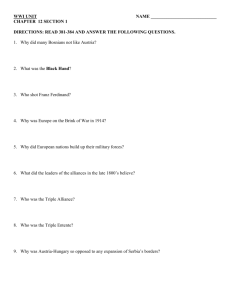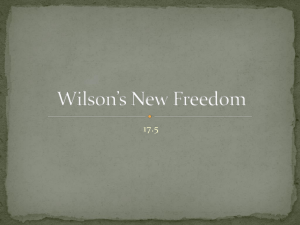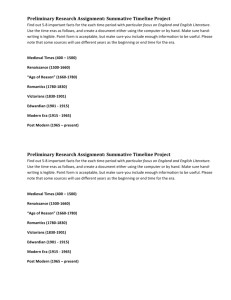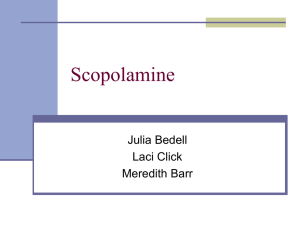Birthing and Anesthesia: The Debate over Twilight Sleep
advertisement
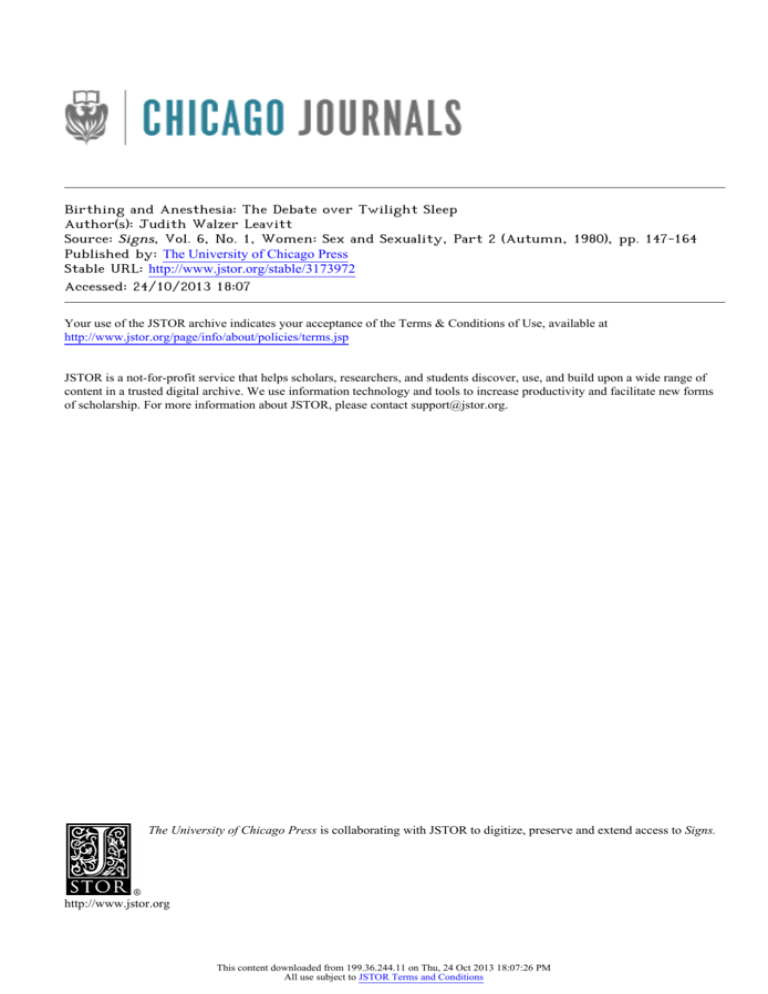
Birthing and Anesthesia: The Debate over Twilight Sleep Author(s): Judith Walzer Leavitt Source: Signs, Vol. 6, No. 1, Women: Sex and Sexuality, Part 2 (Autumn, 1980), pp. 147-164 Published by: The University of Chicago Press Stable URL: http://www.jstor.org/stable/3173972 . Accessed: 24/10/2013 18:07 Your use of the JSTOR archive indicates your acceptance of the Terms & Conditions of Use, available at . http://www.jstor.org/page/info/about/policies/terms.jsp . JSTOR is a not-for-profit service that helps scholars, researchers, and students discover, use, and build upon a wide range of content in a trusted digital archive. We use information technology and tools to increase productivity and facilitate new forms of scholarship. For more information about JSTOR, please contact support@jstor.org. . The University of Chicago Press is collaborating with JSTOR to digitize, preserve and extend access to Signs. http://www.jstor.org This content downloaded from 199.36.244.11 on Thu, 24 Oct 2013 18:07:26 PM All use subject to JSTOR Terms and Conditions REVISIONS/REPORTS Birthingand Anesthesia: The Debate over Twilight Sleep JudithWalzer Leavitt "At midnightI was awakened by a very sharp pain," wrote Mrs. Cecil Stewart,describingthe birthof her child in 1914. "The head nurse ... gave me an injectionof scopolamin-morphin.... I woke up the next morningabout half-pastseven ... the door opened, and the head nurse brought in my baby. ... I was so happy."1 Mrs. Stewarthad delivered her baby under the influenceof scopolamine, a narcoticand amnesiac that, together with morphine, produced a state popularly known as "twilightsleep." She did not rememberanythingof the experience when she woke up after givingbirth.This 1914 ideal contrastswith today's feministstresson being awake, aware, and in controlduring the birthing experience. In 1914 and 1915, thousands of American women testified to the marvelsof havingbabies withoutthe traumaof childbirth.As one of them gratefullyput it,"The nightof myconfinementwillalwaysbe a nightdropped out of mylife."2 I am gratefulto WilliamJ. Orr,Jr.,and Susan Duke fortheirassistancein the preparationof thisstudy.I would also like to thank Mari Jo Buhle, Norman Fost, Susan Friedman, Lewis Leavitt,Elaine Marks, Regina Morantz,and Ronald Numbers for theircommentson earlier draftsof thispaper. 1. Testimonyquoted in MargueriteTracy and Mary Boyd, Painless Childbirth (New York: FrederickA. Stokes Co., 1915), pp. 188-89. For a thoroughaccount of the twilight sleep controversyin America,see Lawrence G. Miller,"Pain, Parturition,and the Profession: The TwilightSleep in America,"in HealthCare in America:Essaysin Social History, ed. Susan Reverby and David Rosner (Philadelphia: Temple UniversityPress, 1979), pp. 19-44. 2. Tracy and Boyd, p. 198. [Signs:Journalof Womenin Cultureand Society1980, vol. 6, no. I] ? 1980 by The Universityof Chicago. 0097-9740/81/0601-0012$01.00 147 This content downloaded from 199.36.244.11 on Thu, 24 Oct 2013 18:07:26 PM All use subject to JSTOR Terms and Conditions 148 Leavitt TwilightSleep From the perspective of today's ideology of woman-controlled births,it may appear that women who want anesthesia sought to cede control of their birthsto their doctors. I will argue however, that the twilightsleep movement led by women in 1914 and 1915 was not a relinquishingof control. Rather,it was an attemptto gain controlover the birthingprocess. Feministwomen wanted the parturient,not the doctor or attendant,to choose the kind of deliveryshe would have. This essay examines the apparent contradictionin the women's demand to controltheirbirthsby going to sleep. TheProcess The attendants,location,and drugs or instrumentsused in American women's birthingexperiences varied in the early decades of the twentiethcentury.America's poorer and immigrantwomen delivered theirbabies predominantlyat home, attended by midwiveswho seldom administereddrugs and who called physiciansonly in difficultcases. A small number of poor women gave birthin charityor public hospitals where physiciansattended them. Most upper- and middle-classwomen, who had more choice, elected to be attended by a physician,usually a general practitionerbut increasinglya specially trained obstetrician, ratherthan a midwife.At the turnof the twentiethcentury,these births, too, typicallytook place in the woman's home; however,by the second decade of the century,specialists,aided partly by the twilightsleep movement,were movingchildbirthfromthe home to the hospital.3 Physiciansused drugs and techniques of physical interventionin many cases, although the extentcannot be quantifiedaccurately.In addition to forceps, physicians relied on opium, chloroform, chloral, cocaine, quinine, nitrousoxide, ergot,and etherto relievepain, expedite labor, prevent injury in precipitous labors, control hemorrhage, and prevent sepsis.4 In one study of 972 consecutive birthsin Wisconsin, physiciansused chloroformduring the second stage of labor in half of theircases and forcepsin 12 percent.5The reportsindicate that drugs and instrumentsmay have made labors shorterbut not necessarilymore enjoyable. Because most drugs could not be used safelythroughoutthe labor and delivery,either because theyaffectedmuscle functionor because theywere dangerous for the baby, women stillexperienced pain. The use of forcepsfrequentlyadded to discomfortand caused perineal tears,complicatingpostdeliveryrecovery.Maternal mortalityremained 3. For more informationon childbirthpracticesin thisperiod, see JudyBarrettLitoff, AmericanMidwives:1860 tothePresent(Westport,Conn.: Greenwood Press, 1978). MedicalJournal3 (1904-5): 257-65. 4. J. F. Ford, "Use of Drugs in Labor," Wisconsin 5. Ibid. This content downloaded from 199.36.244.11 on Thu, 24 Oct 2013 18:07:26 PM All use subject to JSTOR Terms and Conditions Signs Autumn1980 149 high in the early decades of the twentiethcentury, and childbirth, whetherattended by physiciansor midwives,continued to be risky.6 Most women described their physician-attendedchildbirthsas unpleasant at best. Observersof the decliningbirthratesamong America's "better" classes worried that the "fear of childbirthhas poisoned the happiness of many women"7 and caused them to want fewerchildren. One woman told her doctor that her childbirthhad been "hell. ... It burstsyour brain, and tears out your heart,and crashes your nerves to bits.It'sjust like hell,and I won'tstand itagain. Never."8In scopolamine deliveries,the women wentto sleep, delivered theirbabies, and woke up feelingvigorous. The drug altered theirconsciousness so that theydid not rememberpainfullabors,and theirbodies did not feel exhausted by their efforts.9Both the women who demanded scopolamine and the doctors who agreed to use it perceived it as far superior to other anesthesia because it did not inhibitmuscle functionand could be administered throughoutthe birthingprocess. It was the newestand finesttechnique available-"the greatestboon the TwentiethCenturycould give to women," in the words of Dr. Bertha Van Hoosen, one of its foremost medical advocates.10 However, women's bodies experienced their labors, even if their minds did not remember them. Thus observers witnessed women screamingin pain during contractions,thrashingabout, and givingall the outward signs of "acute suffering."Residentsof RiversideDrive in New York City testifiedthat women in Dr. William H. W. Knipe's twilightsleep hospitalsent forth"objectionable"noises in the middle of the night.l1 A successfultwilightsleep delivery,as practicedby Dr. Van Hoosen at the MaryThompson Hospital in Chicago, required elaborate facilities and careful supervision.Attendingphysiciansand nurses gave the first 6. See, e.g., Dorothy Reed Mendenhall ("Prenatal and Natal Conditions in Wisconsin," WisconsinMedicalJournal15 [1917]: 353-69), who reported, "The death rate from maternityis gradually increasingin Wisconsin,as it is throughoutthe United States" (p. birthswere higher 364). Dr. Mendenhall also noted thatdeath ratesforphysician-attended than for midwife-attended birthsin Wisconsin(p. 353). I would like to thank Dale Treleven forcalling thisarticleto myattention. 7. Mary Boyd, "The Storyof Dammerschlaf: An American Woman's Personal Experience and Studyat Freiburg,"Survey33 (1915): 129. 8. Quoted in Russell Kelso Carter, The SleepingCar "Twilight," or Motherhood without Pain (Boston: Chapple PublishingCo., 1915), pp. 10-11. 9. Scopolamine is an alkaloid found in the leaves and seeds of solanaceous plants. It is a sedative and a mild analgesic as well as an amnesiac,causing forgetfulness of pain rather than blockingthe pain sensation. For obstetricaltwilightsleep, scopolamine was administered withmorphine-the most active alkaloid of opium-in the firstdose and alone for subsequent doses. 10. Bertha Van Hoosen, Scopolamine-Morphine Anaesthesia(Chicago: House of Manz, 1915), p. 101. 11. New YorkTimes(June 9, 1917), p. 13. This content downloaded from 199.36.244.11 on Thu, 24 Oct 2013 18:07:26 PM All use subject to JSTOR Terms and Conditions 150 Leavitt TwilightSleep injection of scopolamine as soon as a woman appeared to be in active labor and continued the injections at carefullydetermined intervals throughouther labor and delivery.They periodicallyadministeredtwo teststo determinethe effectivenessof the anesthesia: the "calling test," which the parturientpassed if the doctor could not arouse her even by addressing her in a loud voice, and the "incoordinationtest,"which she passed ifher movementswere uncoordinated.Once the laboringwoman was under the effectsof scopolamine,the doctorsput her intoa specially designed crib-bedto contain her sometimesviolentmovements(see fig. 1). Van Hoosen described the need for the bed screens: "As the pains increase in frequencyand strength,the patient tosses or throwsherself about, but withoutinjuryto herself,and maybe leftwithoutfearthatshe willroll onto the flooror be found wanderingaimlesslyin the corridors. In rare cases, where the patient is veryexcitable and insistson getting out of bed. ... I prefer to fasten a canvas cover over the tops of the screens, therebyshuttingout light,noise and possibilityof leaving the bed.12 When deliverybegan, attendantstook down the canvas crib and positionedthe patientin stirrups,familiarin modern obstetricalservices. Van Hoosen advised the use of a continuous sleeve to ensure that patientsdid not interferewiththe sterilefield(see fig.2). The canvas crib and the continuous sleeve were Van Hoosen's response to a common need in twilightsleep deliveries: a secure, darkened, quiet, contained environment. TheEvents Twilightsleep became a controversialissue in Americanobstetricsin June 1914, when McClure's Magazine published an article by two laywomen describing this newly popular German method of painless childbirth.'3 In the article, Marguerite Tracy and Constance Leupp, both visitorsat the Freiburg women's clinic,criticizedhigh-forcepsdeliveries(which theycalled the common American technique) as dangerous and conducive to infection.They contrastedthese imperfectbirths to the safetyand comfortof twilightsleep. The new method was so wonderfulthatwomen, having once experienced it,would "walk all the way [to Germany] from California" to have their subsequent births under twilightsleep. The physiciansat the Freiburg clinic thoughtthe method was best suited for the upper-class "modern woman .. . [who] responds to the stimulusof severe pain ... withnervousexhaustionand paralysisof the will to carrylabor to conclusion." They were less certain 12. Van Hoosen, p. 42. 13. MargueriteTracy and Constance Leupp, "Painless Childbirth,"McClure'sMagazine 43 (1914): 37-51. This content downloaded from 199.36.244.11 on Thu, 24 Oct 2013 18:07:26 PM All use subject to JSTOR Terms and Conditions I: iP ??" . i?, n;:...?.? s?r;::. iBj?:.`:??i?.g ?;. ?.. ? ?. .-, i: :.Y SiY ?irC ?' .?l??'i. FIG. 1.-Patient in crib-bedwaitingfor examination. (Source: Bertha Van Hoosen. Scopola House of Manz, 1915], p. 48.) This content downloaded from 199.36.244.11 on Thu, 24 Oct 2013 18:07:26 PM All use subject to JSTOR Terms and Conditions ?V~~~~~~~* ' w.S ~ --:l: ?~ tn X~;~t*' :i~!%f.~,~; r:: . ~~ ,~<? t~4s ..~U~a ? V 'I r uetrl FIG. 2.-Gown with continuous sleeve. (Source: Bertha Van Hoosen, ScopolamineMorphineAnaesthesia[Chicago: House of Manz, 1915], p. 88.) This content downloaded from 199.36.244.11 on Thu, 24 Oct 2013 18:07:26 PM All use subject to JSTOR Terms and Conditions Signs Autumn1980 153 about its usefulnessfor women who "earn theirlivingby manual labor" and could toleratemore pain.14 The women who took up the cause of twilightsleep concluded thatit was not in general use in thiscountrybecause doctorswere consciously withholdingthis panacea. Physicianshave "held back" on developing painless childbirth,accused Mary Boyd and Marguerite Tracy, two of the most active proponents,because it "takes too much time." "Women alone," they asserted, "can bring Freiburg methods into American obstetricalpractice."'5Others echoed the call to arms:journalist Hanna Rion urged her readers to "take up the battleforpainless childbirth.... Fight not only foryourselves,but fightfor your ... sex."'6 Newspapers and popular magazinesjoined the chorus, advocatinga widespread use of scopolamine in childbirth.17 The lay public's anger at the medical profession'sapparent refusal to adopt a technique beneficialto women erupted into a national movement. The National Twilight Sleep Association, formed by uppermiddle-classclubwomen,'8was best epitomized by its leaders. They included women such as Mrs.Jesse F. Attwater,editorofFeminain Boston; Dr. Eliza Taylor Ransom, activewomen's rightsadvocate and physician in Boston; Mrs. Julian Heath of the National Housewife's League; author Rheta Childe Dorr of the Committeeon the IndustrialConditions of Women and Children; Mary Ware Dennett of the National Suffrage Association (and later the National Birth Control League); and Dr. Bertha Van Hoosen, outspoken women's leader in medical circles in Chicago.19 Many of these leaders saw the horrors of childbirthas an 14. Ibid., p. 43. For the same sentimentamong American physicians,see, e.g., John O. Polak, "A Study of Scopolamin and Morphine Amnesia as Employed at Long Island 71 (1915): 722; and Henry SmithWilliams, College Hospital,"AmericanJournal ofObstetrics PainlessChildbirth (New York: Goodhue Co., 1914), pp. 90-91. The classic descriptionsof the ideal scopolamine deliveryare Bernhard Kronig,"Painless Deliveryin Dammerschlaf" (1908); and Carl J. Gauss, "Birthsin ArtificialDammerschlaf" (1906) and "Further Experimentsin Dammerschlaf"(1911), all translatedand reprintedin Tracy and Boyd (n. 1 above), pp. 205-308. 15. Mary Boyd and MargueriteTracy, "More about Painless Childbirth,"McClure's Magazine 43 (1914): 57-58. 16. Hanna Rion,PainlessChildbirth in Twilight Sleep (London: T. Werner Laurie Ltd., 1915), p. 239; see also her "The Painless Childbirth,"LadiesHomeJournal31 (1914): 9-10. 17. See, e.g., "Is the Twilight Sleep Safe-for Me?" Woman'sHome Companion42 (1915): 10, 43; WilliamArmstrong,"The 'TwilightSleep' of Freiburg:A Visitto the Much Talked of Women's Clinic," Woman'sHome Companion41 (1914): 4, 69; New YorkTimes (September 17, 1914), p. 8; (November 28, 1914), p. 2. 18. On women's clubs and clubwomen,see MaryP. Ryan,Womanhood inAmerica:From ColonialTimestothePresent(New York: New Viewpoints,1975), pp. 227-32; Edith Hoshino Altbach, Womenin America(Lexington, Mass.: D.C. Heath & Co., 1914), pp. 114-21; William L. O'Neill, EveryoneWas Brave: A HistoryofFeminismin America (Chicago: Quadrangle Books, 1969), pp. 107-68; Sheila M. Rothman, Woman'sProperPlace: A Historyof ChangingIdealsand Practices,1870 tothePresent(New York: Basic Books, 1978), pp. 63-93. 19. Carter,pp. 174-75. This content downloaded from 199.36.244.11 on Thu, 24 Oct 2013 18:07:26 PM All use subject to JSTOR Terms and Conditions 154 Leavitt TwilightSleep experience that united all women: "Childbirthhas for every woman through all time been potentially great emergency."20Dr. Ransom thought that the use of twilightsleep would "create a more perfect motherhood" and urged others to work "for the bettermentof womenkind."2' Because they saw it as an issue for their sex, not just their class, and because many of the twilight sleep leaders were active feminists,theyspoke in the idiom of the woman movement.22 The associationsponsored ralliesin major citiesto acquaint women withthe issue of painless childbirthand to pressure the medical profession into adopting the new method. In order to broaden their appeal, the associationstaged meetings"betweenthe marked-downsuitsand the table linen" of departmentstoreswhere "the ordinarywoman" as well as the activistclubwoman could be found.23At these rallies,women who had traveledto Freiburgtestifiedto thewondersof twilightsleep (see fig. 3). "I experienced absolutelyno pain," claimed Mrs. FrancisX. Carmody of Brooklyn,displayingher healthybaby at Gimbels."An hour aftermy child was born I ate a heartybreakfast.... The thirdday I went for an automobile ride. ... The TwilightSleep is wonderful."Mrs. Carmody ended withthe familiarrallyingcry:"If you women wantit you willhave to fightfor it,forthe mass of doctorsare opposed to it."24 Department-storerallies and extensivepress coverage brought the movement to the attentionof a broad segment of American women. Movement leaders rejoiced over episodes such as the one in which a "tenementhouse mother... collecteda crowd" on a streetcornerwhere she joyfullytold of her twilightsleep experience.25Many working-class women were attracted to twilight sleep not only because it made childbirth"pleasanter" but because they saw its use as "an important cause of decreased mortalityand increased healthand vitalityamong the mothersof children."26Some feared,however,thattwilightsleep would remain a "superadded luxuryof the wealthymother"because it involved so much physician time and hospital expense.27 Although different motivations propelled the physician-advocateswho believed twilight sleep was safe, middle- and upper-classwomen who wanted the newest 20. Tracy and Boyd, p. 145. Club Women1 (1917): 5. I am 21. Eliza Taylor Ransom, "TwilightSleep," Massachusetts this reference. for Morantz Markell to grateful Regina 22. The connectionsbetween clubwomen and suffrageor other women's issues are and explored in Altbach, pp. 114-15; O'Neill, pp. 49-76, 146-68; Ryan, pp. 230-49; in theUnitedStates(New Eleanor Flexner,Century ofStruggle:The Woman'sRightsMovement York: Atheneum Publishers, 1970), pp. 172-92. The term "woman movement,"in the nineteenthand early twentiethcenturies,described the movementto betterwomen's condition,including,but not limitedto, the drive forsuffrage. 23. Tracy and Boyd, p. 145. 24. Quoted in New YorkTimes(November 18, 1914), p. 18. 25. Tracy and Boyd, p. 145. 26. Clara G. Stillman,"Painless Childbirth,"New YorkCall (July 12, 1914), p. 15. SocialistReview 27. Sam Schmalhauser,"The TwilightSleep forWomen,"International 15 (1914): 234-35. I am gratefulto MariJo Buhle forthisand the previous reference. This content downloaded from 199.36.244.11 on Thu, 24 Oct 2013 18:07:26 PM All use subject to JSTOR Terms and Conditions Signs Autumn1980 155 FIG. 3.-Mrs. FrancisXavierCarmodyand "Charlemagne,"born in Freiburg.(Source: [New York: Frederick A. Stokes Marguerite Tracy and Mary Boyd, Painless Childbirth Co., 1915], p. 143.) thingmedicine had to offer,and working-classwomen who wanted simple relieffromchildbed suffering,theywere all united bytheircommon desire to make childbirthsaferand easier forwomen. Van Hoosen emerged as the mostavid advocate of twilightsleep in the Midwest. She received her M.D. from the Universityof Michigan This content downloaded from 199.36.244.11 on Thu, 24 Oct 2013 18:07:26 PM All use subject to JSTOR Terms and Conditions 156 Leavitt TwilightSleep Medical School and worked at the New England Hospital for Women and Children in Boston before settingup practice in Chicago in 1892. Her enthusiasm for the method came from two sources: her strong commitmentto the best in obstetricalcare and her equally strongcommitmentto women's rights.Through her use of scopolamine in surgery and obstetrics,she became convinced thattwilightsleep offeredwomen a "returnof more physiologicalbirths"at the same timethatit increased the efficiencyof physicians,giving them "complete control of everything."28 She guided many other physicians to the twilight sleep method.29In termsof safetyand comfort,she could not imagine a better method of birthing. Increasingly,doctors began to deliver twilightsleep babies. Some traveled to Germanyto learn the Freiburgtechnique and subsequently offeredit to both privateand charitypatients.30A few physicianseven became enthusiasticabout the possibilitiesof twilightsleep. "If the male had to endure this suffering,"said Dr. James Harrar of New York, "I thinkhe would resortveryprecipitouslyto somethingthatmightrelieve the . .. pain."31 Dr. W. Francis B. Wakefield of California went even further,declaring "I would just as soon consider performinga surgical operation withoutan anestheticas conducting a labor withoutscopolamin amnesia. Skillfullyadministered the best interest of both the motherand the child are advanced byitsuse."32Anotherphysicianlisted its advantages: painless labor, reduction of subsequent "nerve exhaustion that comes after a prolonged hard labor," better milk secretion, fewer cervical and perineal lacerations, fewer forcep deliveries, less strain on the heart, and a "better race for future generations" since upper-class women would be more likelyto have babies if theycould have them painlessly.33There was also, it was claimed, an "advantage to 28. Bertha Van Hoosen, PetticoatSurgeon(Chicago: Pellegrini& Cudahy, 1947), pp. 282-82. 29. See, e.g., Bertha Van Hoosen, "A Fixed Dosage in Scopalamine-Morphine Anaesthesia," Woman'sMedical Journal 26 (1916): 57-58; and "Twilight Sleep in the Home," ibid., p. 132. 30. For early American trials,see William H. Wellington Knipe, "'Twilight Sleep' from the Hospital Viewpoint," Modern Hospital 2 (1914): 250-51; A. M. Hilkowich, "Further Observationson Scopalamine-NarcophinAnesthesiaduring Labor withReport of Two Hundred (200) Cases," AmericanMedicine20 (1914): 786-94; William H. WelAmerican lington Knipe, "The Freiburg Method of Dammerschlaf or Twilight Sleep," McPherson, and Ross A. Harrar and 70 Obstetrics 364-71; (1914): James Journal of Association of oftheAmerican "Scopolamine-NarcophinSeminarcosisin Labor," Transactions 27 (1914): 372-89. and Gynecologists Obstetricians 31. Quoted duringdiscussionof Rongy,Harrar, and McPherson papers, Transactions 27 (1914): 389. and Gynecologists the ofObstetricians of AmericanAssociation Journalof 32. W. Francis B. Wakefield,"Scopolamine Amnesia in Labor," American 71 (1915): 428. For more of thiskind of enthusiasm,see also Elizabeth R. Miner, Obstetrics "Letter and Report of Nineteen Cases in Which 'Twilight' Was Used," Woman'sMedical Journal26 (1916): 131. Medicine21 (1915): 40-41. 33. Ralph M. Beach, "TwilightSleep," American This content downloaded from 199.36.244.11 on Thu, 24 Oct 2013 18:07:26 PM All use subject to JSTOR Terms and Conditions Signs Autumn1980 157 the child: To give it a betterchance for life at the time of delivery;a betterchance to have breast-feeding;a betterchance to have a strong, normal mother."34 Despite the energyand enthusiasmof the twilightsleep advocates, many American doctors resistedthe technique. They lashed out against the "pseudo-scientificrubbish" and the "quackish hocus-pocus" published in McClure's35and simplyrefusedto be "stampeded by these misguided ladies."36 These physicians did not believe that nonmedical people should determine therapeutic methods; it was a "question of medical ethics."37Other physiciansrefused to use scopolamine because theyfeared itsdangers eitherto the motheror the child. TheJournalof theAmericanMedical Associationconcluded that "this method has been thoroughly investigated, tried, and found wanting, because of the danger connected withit."38 Because the evidence about safetywas mixed, many doctors were frustratedin theirattemptsto findout whetherscopolamine was harmful or safe for use in obstetrics.Earlier experience with the unstable formof the drug led some to refuseto tryscopolamine again, although at least one pharmaceuticalcompany had solved the problem of drug stabilityby 1914. "The bad and indifferentresultswhich were at first obtained by the use of these drugs we now know to have been due entirelyto overdosage and the use of impure and unstable preparations,"concluded one physicianin a reporton his successfulresultswith 1,000 twilightsleep mothersin 1915.39Dr. Van Hoosen had successfully performed surgeryon 2,000 patientswith the help of scopolamine by 190840 and began using the drug routinelyin deliveries in 1914. She concluded after 100 consecutive cases that scopolamine, properly administered,"solves the problemsof child-bearing"and is safe formother and child.41But the medical literaturecontinued to express concern 34. Bertha Van Hoosen, Scopolamine-Morphine Anaesthesia,p. 101. Some physicians reportedsuccess using twilightsleep at home, but mostthoughtthe method best suited to hospital deliveries. 35. Quoted fromtheJournaloftheAmericanMedicalAssociationin "Another 'Twilight Sleep,' " Literary Digest50 (1915): 187; W. Gillespie,"Analgesicsand Anestheticsin Labor, Their Indication and Contra-Indications,"OhioMedicalJournal11 (1915): 611. 36. "TwilightSleep Again,"AmericanMedicine21 (1915): 149. 37. "'Twilight Sleep' in the Light of Day," ScientificAmerican 79, suppl. 2041 (1915): 112. See also theNew YorkTimes(October 20, 1914), p. 12; (November 28, 1914), p. 12; (February5, 1915), p. 10; (February 11, 1915), p. 8. 38. Journalof theAmericanMedical Association(June 6, 1914), quoted in "'Twilight Sleeps' and Medical Publicity,"Literary Digest49 (1914): 60. 39. Ralph M. Beach, "Twilight Sleep: Report of One Thousand Cases," American 71 (1915): 728. JournalofObstetrics 40. Frederick A. Stratton,"Scopolamine Anesthesia," WisconsinMedicalJournal 8 (1908-9): 27. 41. Van Hoosen, Scopolamine-Morphine Anaesthesia, p. 101. This content downloaded from 199.36.244.11 on Thu, 24 Oct 2013 18:07:26 PM All use subject to JSTOR Terms and Conditions 158 Leavitt TwilightSleep about the possible ill effectsof a breathingirregularityin babies whose mothers had been given scopolamine and morphine late in labor.42 Doctors tryingto understand the evaluation of twilightsleep must have been confused. In one journal, theyread that the procedure was "too dangerous to be pursued," while another journal assured them that scopolamine, when properly used during labor, "has no danger for either motheror child."43Increasingly,by 1915, medicaljournals published studies thatat least cautiouslyfavored twilightsleep (theJanuary Medicinepublished nine such articles),44although 1915 issue of American ran editorials warning of the drug's potential dangers they frequently and stressingthe need for caution. Practicingphysicians faced a dilemma when pregnant women demanded painless childbirth with scopolamine.45 While physiciansdebated the desirabilityof using scopolamine in 1914 and 1915, the public, surer of its position,demanded thattwilight sleep be routinelyavailable to women who wanted it. Hospitals in the major cities responded to these demands and to physicians'growing interestin the method by allowing deliveries of babies the Freiburg way.46In order to gain additional clinical experience, and possiblyin response to some women's requests,some doctors used twilightsleep in hospital charitywards. But the technique was most successful in the specialtywards thereupper- and middle-classpatientsincreasinglygave birthand hospitalattendantsand facilitieswere available. By May 1915, McClure'sMagazine's national surveyreported that the use of twilight 42. This condition,called "oligopnea," usually resolved aftera few hours, but it was it frighteningto observe, especially for attendantswho had no experience with (Gauss, "FurtherExperimentsin Dammerschlaf,"p. 302). 7 Journalof Obstetrics 43. See discussion of the Polak paper (n. 14 above) in American 793. and Hilkowich, p. (1915): 798; 44. AmericanMedicine21 (1915): 24-70. 45. See, e.g., the discussion followingKnipe's paper (n. 30 above) in the American 70 (1914): 1025. For articleswithpositiveconclusions,see JohnOsborn JournalofObstetrics Polock, "A Study of TwilightSleep," New YorkMedicalJournal101 (1915): 293; Robert T. Gillmore,"Scopolamine and Morphine in Obstetricsand Surgery,"New YorkMedicalJournal 102 (1915): 298; William H. WellingtonKnipe, "'Twilight Sleep' fromthe Hospital American Viewpoint,"p. 250; W. Francis B. Wakefield,"Scopolamin-Amnesiain Labor," 71 (1915): 428; Samuel J. Druskinand Nathan Ratnoff,"TwilightSleep JournalofObstetrics in Obstetrics-with a Report of 200 Cases," New YorkStateJournalof Medicine15 (1915): Gynecol152; Charles B. Reed, "A Contributionto the Studyof 'TwilightSleep,' " Surgery, 22 (1916): 656. For a negative conclusion, see Joseph Louis Baer, ogy and Obstetrics AmericanMedicalAssociation64 "Scopolamin-MorphinTreatment in Labor,"Journalof the to dosage and timing, varied the of actual The according 1723-28. drug dangers (1915): and it is impossibleforthe historianto assess the eventsaccuratelywithoutindividualcase records. Any drug can be dangerous if misused, and the variabilityin advance about it. scopolamine suggeststhatsome disastersoccurred with 46. E.g., see New YorkTimes(August 22, 1914), p. 9; and (September 10, 1914); and the American hospitalsmentioned in Tracy and Boyd. This content downloaded from 199.36.244.11 on Thu, 24 Oct 2013 18:07:26 PM All use subject to JSTOR Terms and Conditions Autumn1980 Signs 159 sleep, although stillbattlingfor acceptance, "gains steadily"around the country.47 Because of the need for expertiseand extra care in administration of scopolamine, the twilightsleep movementeasily fed into widespread effortsin the second decade of the twentiethcenturyto upgrade obstetrical practiceand eliminatemidwives.48Both the women who demanded the technique and the doctors who adopted it applauded the new specialtyof obstetrics.Mary Boyd desired to put an end to home deliveries when she advocated twilightsleep forcharitypatients:"Justas the village barber no longer performsoperations, the untrained midwifeof the neighborhoodwill pass out of existenceunder the effectivecompetition of free painless wards."49Not only did scopolamine advocates try to displace midwives,but they also regarded general practitionersas unqualified to deliver twilightsleep babies. "The twentiethcenturywoman will no more think of having an ordinary practitionerattend her in childbed at her own home," said two supporters, "she will go to a [twilightsleep] hospital as a matterof course."50Specialistsagreed that "the method is not adapted for the general practitioner,but should be practiced only by those who devote themselvesto obstetrics."51Eliza Taylor Ransom wentso faras to recommendthe passage of a federallaw forbidding"anyone administeringscopolamine withouta course of instructionand a special license."52 Some obstetriciansused this issue to discredit their general practitionercolleagues and the midwiveswho stilldeliveredlarge numbersof America'sbabies. Anotherfactorthatmighthave pushed obstetriciansto support twilightsleep was thatbirthsunder scopolamine could be managed more completelyby the physician.As one succinctlyput it, anesthesia gave "absolute controlover your patientat all stagesof the game. ... You are 'boss.' "53 Physicians'timeat the bedside could even be used forother pursuits."I catch up on myreading and writing,"testifiedone practitioner,"I am never harassed by relativeswho wantme to tell them things."54 47. Anna Steele Richardson's surveywas reported in the New YorkTimes(May 10, 1915), p. 24. 48. Litoff(n. 3 above), pp. 69-70. 49. Mary Boyd, "The Storyof Dammerschlaf,"Survey33 (1914): 129. See the same statementin Boyd and Tracy, p. 69. 50. Constance Leupp and BurtonJ. Hendrick,"Twilight Sleep in America,"McClure's Magazine 44 (1915): 172-73. The argumentabout expertiseappeared repeatedly(see, e.g., William H. W. Knipe, "The Truth about Twilight Sleep," Delineator 85 [1914]: 4). Twilightsleep women were aware that theirswas an expensive demand. They expected the cost of physician-attendedchildbirthto jump from to eighty-five dollars twenty-five (Tracy and Boyd, p. 180). 51. Druskin and Ratnoff,p. 1520. 52. New YorkTimes(April 30, 1915). p. 8. 53. Quoted fromtheNew OrleansMedicaland SurgicalJournalin Miller(n. 1 above), p. Van Hoosen, Petticoat 4. 282. 54. Van Hoosen, PetticoatSurgeon, Surgeon,p. p. 282. This content downloaded from 199.36.244.11 on Thu, 24 Oct 2013 18:07:26 PM All use subject to JSTOR Terms and Conditions 160 Leavitt TwilightSleep TheIssue ofControl How do we explain the seeming contradictionsin this episode in medical history?Why did women demand to undergo a process which manyphysiciansdeemed riskyand in whichparturientslostself-control? Why did some physiciansresista process thatwould have given women an easier birthingexperience and would have reinforced physicians' controlover childbirthin a hospitalenvironment? Several factorscontributedto the open tensions about the use of twilightsleep. One was safety.Many physiciansrejected scopolamine because they did not have access to facilitieslike those at the Mary Thompson Hospital or because theybelieved the drug too riskyunder any circumstances.Because of the variabilityamong physicians'use of scopolamine and thecontradictoryevidence in the professionaljournals, we know that safetywas a guiding motivationof manyphysicians.However, this is not enough to explain physicianreluctance since so many doctors administered other drugs during labor despite questionable safetyreports.55Differingperceptionsabout pain during childbirthalso contributedto the intensityof feelingabout twilightsleep in 1914 and 1915. Althoughmanyphysiciansbelieved thatwomen's "extremelydelicate nervous sensibilities"needed relief,others were reluctantto interferewiththe natural process of childbirth.One anti-twilight sleep physician argued, "when we reflectthat we are dealing with a perfectly healthy individual, and an organ engaged in a purely physiological function... I fail to see the necessityof institutingsuch a measure in a normal labor and attempt[ing]to bridge the parturientwoman over this physiological process in a semi-conscious condition."56Women perceived, too, that some physiciansused anesthesia only for "suffering when it becomes a serious impedimentto the birthprocess."57However, women who had sufferedgreatly,or whose friendshad sufferedgreatly, activelysought relief from their "physiological"births: They thought pain in itselfa hindrance to a successfulchildbirthexperience and "demanded" that their physicians provide them with more positive, less painful,experiences in the future.58 Both sides in the twilightsleep debate grappled witha thirdimportant question: whetherthe women or the attendantsshould determine 55. Fiftypercent of 100 general practitionerssurveyed in rural districtsand small towns in Wisconsin indicated that they used ergot during labor, although its use was blamed for"a verylarge per cent of necessaryoperations for repair of injuriesto the floor and pelvic organs of the female patient"(Ford [n. 4 above], p. 257). 56. Dr. Francis Reder, during a discussion of Rongy, Harrar, and MacPherson pa27 (1914): 386. and Gynecologists Association ofObstetricians oftheAmerican pers, Transactions 57. Tracy and Boyd, p. 149. 58. For physicians'perceptionsof "demanding" women, see, e.g., the discussion folAssociation ofObstetricians oftheAmerican lowingthe Rongy and Harrar papers, Transactions 27 (1914): 382-83. and Gynecologists This content downloaded from 199.36.244.11 on Thu, 24 Oct 2013 18:07:26 PM All use subject to JSTOR Terms and Conditions Signs Autumn1980 161 and control the birthingprocess.59The women who demanded that doctorsput themto sleep were partiallyblind to the safetyissue because the issue of control(over pain, bodilyfunction,decision making) was so importantto them. Control became importantwhen doctors refused to allow women "to receivethe same benefitsfromthisgreatdiscoverythat their sistersabroad are getting."60Twilightsleep advocates demanded their right to decide how they would have their children. Tracy and Boyd articulated this issue: "Women took their doctor's word before. They are now beginning to believe ... that the use of painlessness should be at theirdiscretion."61Although women were out of control during twilightsleep births-unconscious and needing crib-bedsor constantattentionto restraintheirwild movements-this loss of controlwas less importantto them than theirdeterminationto controlthe decision about what kind of labor and deliverythey would have. Hanna Rion, whose influential book and articles had garnered support for the method,wrote: In the old-fashioneddays when women were merelytheblindfolded guardians of the power of child-bearing,theyhad no choice but to trustthemselveswithoutquestion in the hands of the all-wisephysician, but thatday is past and willreturnno more. Women have torn away the bandages of false modesty;theyare no longer ashamed of their bodies; theywant to know all the wondrous workingsof nature, and theydemand that theybe taught how best to safeguard themselvesas wives and mothers.When it comes to the supreme functionof childbearing every woman should certainlyhave the choice of sayinghowshe willhave her child.62 Twilightsleep women wanted to controltheirown birthsby choosing to go to sleep. They were not succumbingto physiciansor technologybut were, theythought,demanding the rightto control theirown birthing experiences. This feministemphasis on controlover decision makingappears in the writingsand lectures of the twilightsleep movement; its followers sought simple relief from pain.63 Many leaders were active suffragists 59. Other contributingfactorscannot be developed here. Growing professionalization and specialization with medicine produced tensions among groups of doctors that surfaced during this debate. The method's German "origins" invalidated it with many Americansduring the war years. My emphasis here on the issue of controlis not meant to minimizethese and other factors.However, because others,especiallyLawrence Miller(n. 1 above) have explored the general outlines,I have focused on the previouslyunanalyzed question of decision-makingpower. Its importance,I think,is indicatedby the intensityin the women's argumentson thisissue. 60. Letter from"Ex-Medicus" in New YorkTimes(November 28, 1914), p. 12. 61. Tracy and Boyd, p. 147 (emphasis in original). 62. Rion (n. 16 above), p. 47. 63. Tracy and Boyd claimed "four to fivemillion"twilightsleep followers, obviously an exaggeration(p. 144). This content downloaded from 199.36.244.11 on Thu, 24 Oct 2013 18:07:26 PM All use subject to JSTOR Terms and Conditions 162 Leavitt TwilightSleep whose commitmentto twilightsleep was rooted in theirbeliefin women's rights.64Althoughthese activistsagreed withmost physiciansthatbirth should increasinglybe the domain of the obstetriciansand thatwomen should not sufferunnecessarily,theydisagreed vehementlyabout who should decide what the birthingwoman's experience would be. They clearlyand adamantlywanted women to have the rightto decide their own method of birthing.65 In the face of advancing obstetricaltechnology,many physicians wanted to retain theirtraditionalprofessionalrightand duty to decide therapy on the basis of theirjudgment about the medical indications. They refused to be "dragooned" into "indiscriminateadoption" of a procedure that theythemselvesdid not choose.66Even the doctors who supported twilightsleep believed thatin the finalanalysis,the method of childbirthwas "a question for the attendingman and not the patientto decide."67It was principallythisquestion of power over decision making thatseparated the movement'sproponentsfromitsopponents. TheDecline In the very successes of the twilightsleep movementlay the seeds for itsdemise. Pressured by the clubwomen'sassociationsand theirown pregnant patients,doctors who had not been trained in the Freiburg method delivered babies with scopolamine. There was an enormous variationin the use of the drug, its timingthroughlabor, the conditions in which the woman labored, and the watchfulnessof attendants.As its advocates had feared, problems emerged when scopolamine was not properly monitoredin a hospital setting.Following reportsof adverse effectson the newborn,the drug fellinto ill repute, and some hospitals that had been among the first to use it stopped administering it routinely.68 Those physicianswho continued to advocate twilightsleep believed thataccidentswere due to misuse of the Freiburgmethod and not to the drug itself.Commentingon its discontinuationat Michael Reese Hospital in Chicago, Dr. Bertha Van Hoosen noted that"it is... probable that thisadverse reportdemonstratesnothingmore than the inexperienceof the people using thisanesthetic."69Dr. Ralph Beach agreed that"thereis no doubt thatall of the bad resultswhichhave been reporteddue to this 64. 65. above). 66. 67. See, e.g., New YorkTimes(November 28, 1914), p. 12. See esp. Tracy and Boyd, Rion, Ransom (n. 21 above), and Van Hoosen (n. 10 New YorkTimes(September 26, 1914), p. 10. Dr. ArthurJ.Booker in his remarksdefendingVan Hoosen's use of scopolamine, Anaesthesia, p. 12. quoted in Van Hoosen, Scopolamine-Morphine 68. New YorkTimes(April 24, 1915), p. 10; (April 30, 1915), p. 8; (May 29, 1915), p. 20; (August 25, 1915), p. 10; (August 16, 1916), p. 7. 69. Van Hoosen, "A Fixed Dosage" (n. 29 above), p. 57. This content downloaded from 199.36.244.11 on Thu, 24 Oct 2013 18:07:26 PM All use subject to JSTOR Terms and Conditions Signs Autumn1980 163 method,are due to an impropertechnic,or the administrationof unstable preparations."70Simultaneously,in 1915, some hospitalsexpanded theirobstetricservicesto offertwilightsleep, and others began cutting back its use. Eitherbecause theyjudged the drug dangerous or because they did not use it correctly,some hospitals found the method too troublesome to administer on a routine basis to all patients. Most reached a compromiseand continued to use scopolamine during labor's firststage (when it was deemed safe), thus preemptingtheir patients' protestswithoutcompromisingtheirmedical beliefs.A second inhibitory factorappeared in August 1915 when Mrs. Francis X. Carmody,one of the country'sleading exponents of twilightsleep, died during childbirth at Long Island College Hospital in New York. Althoughdoctorsand her husband insisted that her death was unrelated to scopolamine, it nonethelessharmed the movement.7'Mrs. Carmody's neighbor started a new movementto oppose twilightsleep, and women became more alert to the question of safetythan theyhad been.72Doctors and some former of twilightsleep advocates,emphasizingtheissues of safetyand difficulty other methods of administration,began exploring achieving painless childbirth.73 The obstetricliteratureafter 1915 indicates that twilightsleep did not die in that year. The women's movementmay have failed to make scopalamine routinelyavailable to all laboringwomen, but it succeeded in making the concept of painless childbirthmore acceptable and in adding scopolamine to the obstetricpharmacopoeia. In fact,obstetricians continued to use scopolamine into the 1960s during the firststage of hospital births.74The use of anesthesia (including scopolamine) in childbirthgrewin the yearsafter1915, since women,aware of the possibilityof painlessness,continued to want "shorterand less painful parturition"and since physiciansfelt they could disregard these desires "onlyat great riskto [their]own practice."75 The attemptby a group of women, including some feminists,to control their birthingexperiences backfired.The medical profession retained the choice of birthprocedures and perhaps gained additional 70. Beach (n. 33 above), p. 43. 71. New YorkTimes(August 24, 1915), p. 7. 72. Ibid. (August 31, 1915), p. 5. 73. See, e.g., Frank W. Lynch,"NitrousOxide Gas Analgesia in Obstetrics,"Journal of theAmericanMedicalAssociation 64 (1915): 813. 74. See, e.g., Henry Schwarz, "Painless Childbirthand the Safe Conduct of Labor," American and DiseasesofWomenand Children79 (1919): 46-63; and W. C. JournalofObstetrics Danforthand C. Henry Davis, "ObstetricAnalgesia and Anesthesia,"Journal oftheAmerican MedicalAssociation 81 (1923): 1090-96. 75. See the assessment of anesthesia used in childbirthin New York Academy of Medicine Committee on Public Health Relations,MaternalMortality in New YorkCity:A Studyofall PuerperalDeaths1930-1932 (New York: CommonwealthFund, 1933), p. 113; see also JoyceAntlerand Daniel M. Fox, "Movement toward a Safe Maternity:Physician Accountabilityin New York City,1915-1940," BulletinoftheHistoryofMedicine50 (1976): 569-95. This content downloaded from 199.36.244.11 on Thu, 24 Oct 2013 18:07:26 PM All use subject to JSTOR Terms and Conditions 164 Leavitt TwilightSleep control as a resultof this episode. Partial acceptance by the profession quieted the lay revolt,and women lostthe power theyhad sought. Ironically,by encouraging women to go to sleep during theirdeliveries,the twilightsleep movementhelped to distance women from their bodies. Put to sleep with a varietyof drugs, most parturientwomen from the 1920s to the 1960s did not experience one of theirbodies' mostpowerful actions and thus lost touch with their own physical potential.76The twilightsleep movementhelped change the definitionof birthingfroma natural home event, as it was in the nineteenthcentury,to an illness requiringhospitalizationand physicianattendance. Parturientfeminists today, seeking fullyto experience childbirth,paradoxicallymust fighta traditionof drugged, hospital-controlledbirths,itselfthe partial result of a struggleto increase women's controlover theirbodies. and Women'sStudiesProgram HistoryofMedicineDepartment ofWisconsin-Madison University 76. The legacy for the parent-infantbond and for subsequent child development is explored in M. H. Klaus and J. H. Kennell,MaternalInfantBonding:The Impactof Early (St. Louis: C. V. Mosby Co., 1976). For a feminist Separationor Loss on FamilyDevelopment perspective on women's missing their deliveries, see Adrienne Rich, Of WomanBorn: as Experience and Institution Motherhood (New York: W. W. Norton & Co., 1976). This content downloaded from 199.36.244.11 on Thu, 24 Oct 2013 18:07:26 PM All use subject to JSTOR Terms and Conditions
